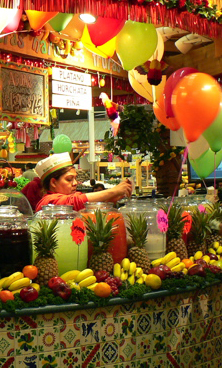
Day and Night at the Ranch Market
I went to the Ranch Market on South
Central Avenue and Southern for lunch a few days ago and then for
dessert last night. PiŮatas and balloons hang from the ceiling and
colorful baskets of fruit are everywhere. The market looks very
different during the day than it does at night. During lunch there
is such a commotion of Latino families with young children,
Caucasian office workers and tradesmen of all ethnicities. Everyone
is looking at the menu and the hot tables for ideas for lunch while
being sure to keep their place in line. Two televisions perched
above the crowd are tuned to Spanish networks. Customer sit at long
wooden picnic tables (more than twice the size of a regular picnic
table) in little clusters huddled together so they can hear one
another talk. Itís hard to hear because there is loud mariachi
music playing and all the cooking and sales stations (bakery,
kitchen, beverage, dairy) open on to the eating area. The
restaurant area is vibrant and busy. Of course all the customers
are talking. Loudly.

I caught passing phrases of English
in the crowd, but all wait staff spoke only Spanish. The girl that
took my lunch order did not speak English. I speak only enough
Spanish to get me in trouble, but on this day it worked out well
because I got two of the best red chili tamales. The vibrantly
colored signs describing the dishes being served are mostly in
Spanish. Bursts of English sprouted occasionally on a sign
advertising a lunch special. That was a nod of recognition to the
large group of Caucasian office workers and tradesmen who frequent
the business during lunch, but it was clear that this business
catered to newcomers from Mexico.
There was a mix of ethnicities
during the day, but at night, my son Jake and I were the only
Gringos. The only Gringo patrons, I should say, because on the way
out I noticed a little tax preparation booth. The people that
staffed that booth were definitely guera. I heard the tax man
speaking English. I should have asked if he spoke Spanish, but I
didnít. Everyone else I tried to talk to did not speak English.
One girl got a little miffed with me when I could not understand
what she was saying. I was trying to buy some strawberries with
cream. She gave me that slight exasperated sigh and a little roll
of the eyes, the way Iíve seen Caucasian merchants do many times
with a Latino customer.
 Iím so glad I. took my son along.
There were no single people during the night visit. Pairs of men
sat together. There were also families with young children. Maybe
half of the people in the store were children. At several tables in
the cafeteria area, fathers watched their children while their wives
shopped, but I didnít spot one single person during the half hour we
were there. Itís funny, the strange things that you notice
sometimes, but that night I noticed three men giving their wives
money for a purchase. I can not remember the last time I saw that.
I remember my dad giving my mother money when I was a child. I will
have to look out for that now, to see if it happens in my
neighborhood. It seems that the old male breadwinner model still
survives in this energetic community of migrants. Iím so glad I. took my son along.
There were no single people during the night visit. Pairs of men
sat together. There were also families with young children. Maybe
half of the people in the store were children. At several tables in
the cafeteria area, fathers watched their children while their wives
shopped, but I didnít spot one single person during the half hour we
were there. Itís funny, the strange things that you notice
sometimes, but that night I noticed three men giving their wives
money for a purchase. I can not remember the last time I saw that.
I remember my dad giving my mother money when I was a child. I will
have to look out for that now, to see if it happens in my
neighborhood. It seems that the old male breadwinner model still
survives in this energetic community of migrants.
My thoughts were disrupted by two
young, strikingly handsome boys whose entry into the store seemed to
cause a little stir. These young men stood out from the other
patrons because they had clearly made the transition to the American
culture. They could have been twins, maybe seventeen or eighteen
years old. They both had long, dark, blunt cut hair and were
dressed all in black. They looked a little gothic, one with a long
black coat and a Nine Inch Nails t-shirt peeking out, the other with
a silver chain belt. Just a touch of sub-cultural gothic, but it
was quite the ďstepping outĒ in this setting.
On the way out my son and I were
waylaid by a barbeque chicken stand that spilled out onto the
parking lot in the front of the market. The setting was just the
cultural commandeering of space that James Rojas described in The
Latino Use of Urban Space in East Los Angles (Urban Latino Cultures,
1999). There were more picnic tables and plastic chairs that could
be moved around for better conversations. Everyone that passed
slowed down to inhale the fragrance and admire what was on the
grill.
There is not a better aroma than
roasting chicken. We were both full from the desert we had just
enjoyed, but were almost tempted by the roasted corn. We watched a
young girl slather the corn with mayonnaise; coat it with parmesan
cheese and season with hot sauce. What a strange combination, but
the man that was waiting for it said that roasted corn was delicious
this way. My son and I agreed to come back for dinner. |